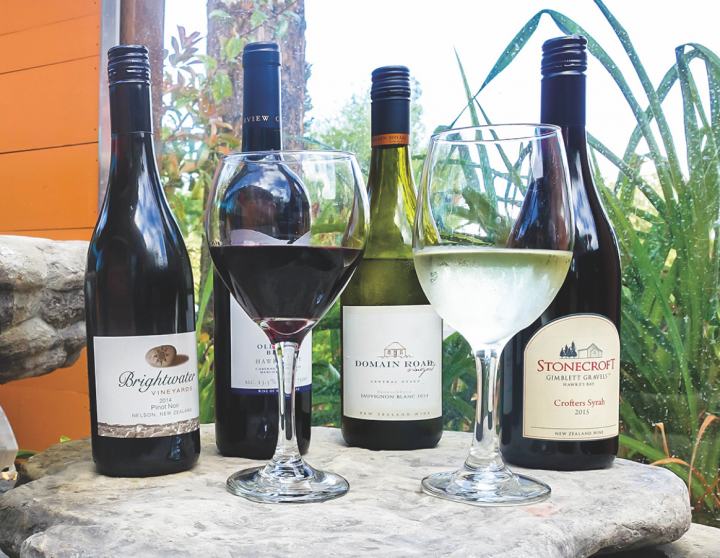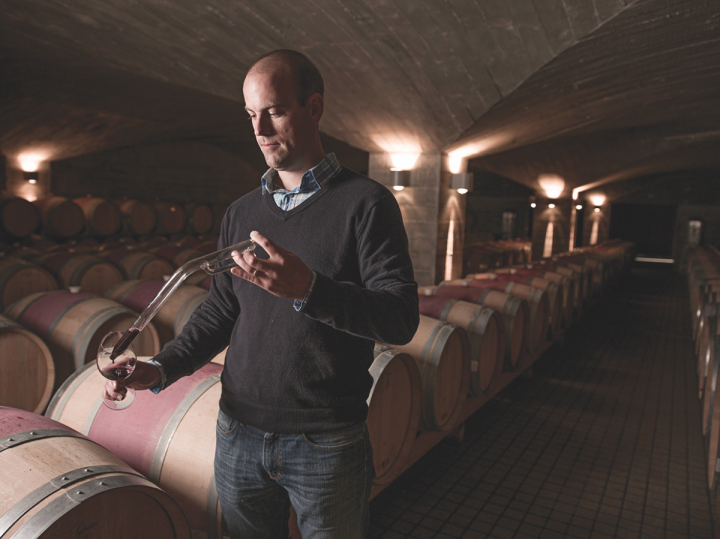
With more than 40 New Zealand entries on its wine list, Aroha Restaurant in West Lake Village, California, has been at the forefront of educating its customers on the diversity of New Zealand wines. “Sauvignon Blancs have always done very well, but in recent years New Zealand has been coming out with some really unique wines,” says Aroha head chef and owner Gwithyen Thomas, whose venue serves upscale New Zealand cuisine. While the country’s Pinot Noirs have garnered attention, Thomas notes that even lesser-known varietals like Seifried Estate Winery’s 2014 Zweigelt ($12 a glass; $36 a 750-ml.) and 2014 Würzer ($14; $42) from the Nelson region are a hit with customers. “The market is saying it wants unique varietals that have not been traditionally associated with New Zealand,” he says.
Aroha offers only New Zealand wines by the glass, in addition to a broader selection of local and international wines by the bottle. “For a restaurant in California with an emphasis on New Zealand, I don’t really have to push those wines. I sell them more than anything else,” Thomas says. The restaurant features nine Pinot Noirs by the bottle from different growing regions in New Zealand, like the 2013 Forrest Estate from Marlborough ($14 a glass; $42 a 750-ml.), the 2006 Shaky Bridge Pioneer from Central Otago ($18; $54) and the 2014 Brightwater from Nelson ($19; $57). “With these wines you can taste the vastly different characteristics of each region,” Thomas adds.
At New York City’s The Musket Room, wine director Brett Feore also showcases a range of New Zealand varietals and regions, including Quartz Reef Rosé NV Brut from Bendigo ($19 a glass), 2012 Rippon Vineyard Mature Vines Pinot Noir from Lake Wanaka in Central Otago ($145 a 750-ml.) and 2011 Ostler Lakeside Riesling from Waitaki Valley ($71). The restaurant’s wine list is comprised of about 70-percent New Zealand wines and features a robust selection of Sauvignon Blanc, Chardonnay, Pinot Noir, Syrah and red blends, among others. “Most people only know about Sauvignon Blanc, or they know nothing of New Zealand wines,” Feore says. “I feel like I’m sitting on the best-kept secret in wine.”

Virtually unknown in the United States two decades ago, wines from New Zealand have since become synonymous with Sauvignon Blanc and the Marlborough region. But as consumers become more familiar with the country’s quality and value, they’re increasingly eager to explore what the rest of the two islands have to offer. “We’re raising awareness, but it’s a gradual process,” Feore says.
Last year, New Zealand ranked as the sixth-largest imported table wine category, excluding bulk, in the United States, according to Impact Databank, but it remains far behind other top import players like Italy and Chile. With 14-percent volume growth in 2016 following years of impressive gains, New Zealand appears primed to compete with some of the more established countries. In 1997, New Zealand’s total table wine imports to the United States stood at less than 75,000 nine-liter cases, but between 2000 and 2005 imports grew nearly fivefold, according to Impact Databank. Since 2010, New Zealand imports in the United States increased by 82 percent, reaching 4.7 million cases after gaining nearly 527,000 cases last year alone. That momentum shows no sign of slowing, as nearly all of the leading New Zealand brands posted consistent double-digit gains.
New Zealand is a relatively small country whose unique geography offers dramatic variations in climatic conditions and soil. Comprised of the North Island and South Island, New Zealand features 10 distinctive cool-climate winegrowing regions spanning 1,000 miles, predominantly along the country’s eastern coastlines. In July, New Zealand’s Geographic Indications bill for its native wine and spirits went into effect, and 18 regions have submitted applications for official registration.
The majority of New Zealand wines in the United States hail from Marlborough, while Hawke’s Bay, Central Otago and Martinborough/Wairarapa have a growing presence in the market. “Central Otago and Martinborough have gained a strong reputation for Pinot Noir, while the second-largest region, Hawke’s Bay, is producing excellent cool-climate Cabernet/Merlot blends, Syrah and Chardonnay,” says David Strada, U.S. marketing manager for the New Zealand Winegrowers trade association. “Nelson and North Canterbury excel with Pinot Noir and aromatics like Riesling, Pinot Gris and Gewürztraminer.”
Marlborough, which is located on the South Island, is New Zealand’s largest designated wine-growing region, with about two-thirds of the country’s planted vines. It rose to prominence on the world stage for Sauvignon Blanc beginning in the 1980s. Marlborough is divided between the newer subregions of Southern Valleys, Wairau Valley and Awatere Valley, each with varying soil and microclimates. Sauvignon Blanc is the region’s most extensively planted varietal, with Pinot Noir, Chardonnay, and aromatics like Pinot Gris, Gewürztraminer, Riesling and Viognier also planted to a lesser extent.

Branching Out
New Zealand’s Craggy Range Winery produces a host of wines across its three vineyards located in Hawke’s Bay, Martinborough and Marlborough. Its most popular wines include Te Muna Road Sauvignon Blanc ($24 a 750-ml.) and Pinot Noir ($135), both from Martinborough, as well as Le Sol Syrah ($135) from its Gimblett Gravels vineyard in Hawke’s Bay. “The cooler spring conditions in Martinborough reduce Sauvignon Blanc yields compared to those from Marlborough. Along with finishing dry, our Sauvignon Blanc has shown great versatility across many styles of cuisine,” says Matt Stafford, chief winemaker at Craggy Range. “The Martinborough wines dominate our exposure in the United States.”
Outside the larger winegrowing regions, there’s increasing enthusiasm for lesser-known areas. “Regions like Clevedon, south of Auckland, and Waiheke Island are making some amazing Bordeaux blends,” says Feore of The Musket Room. Stonyridge Vineyard on Waiheke Island is a popular option on the restaurant’s wine list, which features its 2014 Pilgrim Syrah/Mourvèdre ($175 a 750-ml.). While Feore admits Chardonnay is a crowded category, New Zealand Chardonnays are a rising segment, with standouts like the 2015 Neudorf Rosie’s Block Chardonnay ($75).

Amid a growing interest in organic and biodynamic wines, Feore sees New Zealand wines fitting well with the trend. As a country with little pollution and inherently green practices, most winemakers employ organic growing techniques. Milton Vineyard in Gisborne was the first producer in New Zealand to gain organic certification in 1989. “Almost everything is sustainably practiced and organic, whether it’s certified or not. That’s just they way they do it,” Feore explains.
Leading the New Zealand category with over a million cases in the United States last year is Constellation Brands’ Kim Crawford. Its Sauvignon Blanc is by far the most popular wine in the portfolio, but Chardonnay and rosé are a growing part of its U.S. presence as well. Constellation introduced Kim Crawford Rosé ($18 a 750-ml.), made with 100-percent Hawke’s Bay Merlot, this past April, and has already seen a strong response. “Some of the most exciting rosés are coming from unexpected regions and varieties, giving rosé fans something new to try,” says Jon Guggino, vice president of marketing for super-premium, ultra-premium and global import wines at Constellation. “New Zealand is aiming to break out of being a one-varietal country of origin as other varietals, like Pinot Noir, gain traction.”

New Takes On Tradition
While awareness is rising for some of New Zealand’s more obscure varietals and regions, producers are also looking to new styles of the country’s signature grapes. Aroha Restaurant features a number of sparkling wines from Marlborough, Hawke’s Bay and Central Otago, such as the 2015 Hillersden Sparkling Sauvignon Blanc ($12 a glass; $36 a 750-ml.) and The Doctors Spark Sauvignon Blanc ($16; $48), which are both from Marlborough. “Winemakers are starting to focus on traditional styles, but done differently,” Thomas says. “It’s becoming a trend to use some of the familiar wines and have them in a bubbly state, and that’s helping lift sales.”
Even amid growing interest in less familiar labels, Sauvignon Blanc and Pinot Noir remain the center of attention for New Zealand. The country’s total wine production this year was dominated by Sauvignon Blanc with a 76-percent share of white varietals, while Chardonnay was second at 11 percent, according to the New Zealand Winegrowers. Pinot Noir led red varietal production with a 72-percent share, while Merlot followed at 15 percent.
Constellation is watching the trend toward premiumization of white wines for its Kim Crawford and Nobilo brands. In 2016, Nobilo grew by nearly 10 percent in the U.S. market to 615,000 cases, according to Impact Databank. Its popular Sauvignon Blanc and Pinot Noir are produced across four vineyards located predominantly along the coasts in Marlborough, Gisborne, Hawke’s Bay and Central Otago. For now, the company says the concentration for Nobilo is growing its existing portfolio.
Craggy Range is also focusing on building its Pinot Noir in the United States, especially in on-premise channels. Looking ahead, Stafford is making sure there’s enough supply for the winery’s most popular wines as awareness grows. “The demand for Sauvignon Blanc is not showing any signs of slowing yet, so we’re looking to extend our plantings,” he says.

Coming of Age
As consumer education and awareness build, many in the industry see the quality of New Zealand’s wines improving as the vines mature and winemakers sharpen their skills. “We’re starting to see a less-is-more, hands-off approach, letting the wines speak for themselves. They’re really showing a sense of origin,” says The Musket Room’s Feore. With an average vine age of about 15 years, he sees great potential over the next 10 to 15 years. “Not only are the vines maturing, but the winemaking skill-sets and winemakers themselves are maturing.”
As New Zealand wine’s largest export market, the United States is playing a major role in achieving the country’s export target of $2 billion by 2020. But in addition to building awareness and education, New Zealand wine producers must also compete against a strong domestic wine market in the United States. Craggy Range’s Stafford says the increasing maturity of styles is starting to come through in its wines, which helps distinguish New Zealand from domestic wines. “Our Marlborough Pinot Noirs are still being discovered, but against the richness of commercial California Pinot Noir the classical feel of our wines has been a little overshadowed,” he says.
Despite a competitive market, New Zealand is a reliable proposition for distinctive, high-quality wines across all tiers. “We want people to broaden their palates and recognize the diversity of New Zealand wine, even within Sauvignon Blanc,” says New Zealand Winegrowers’ Strada. “Anyone who believes they’re all alike needs to do more tasting.”